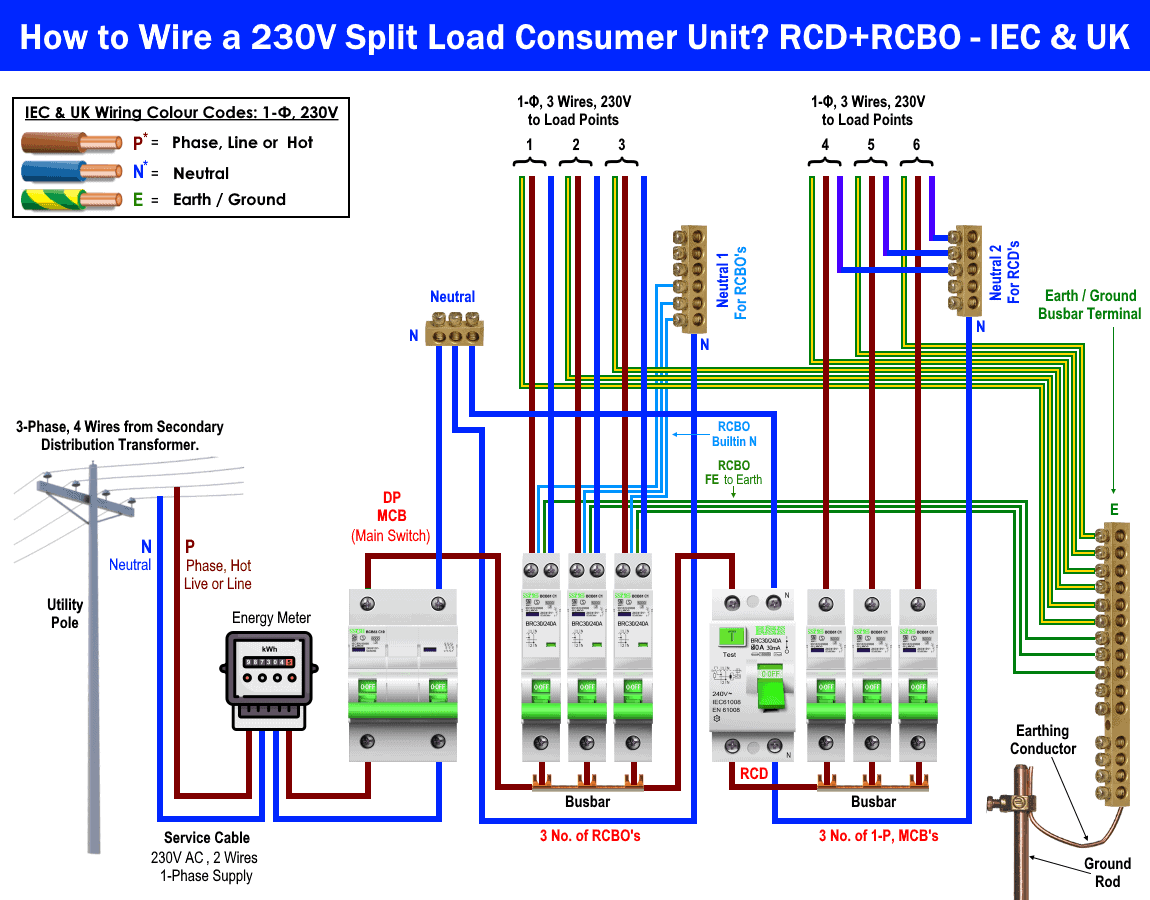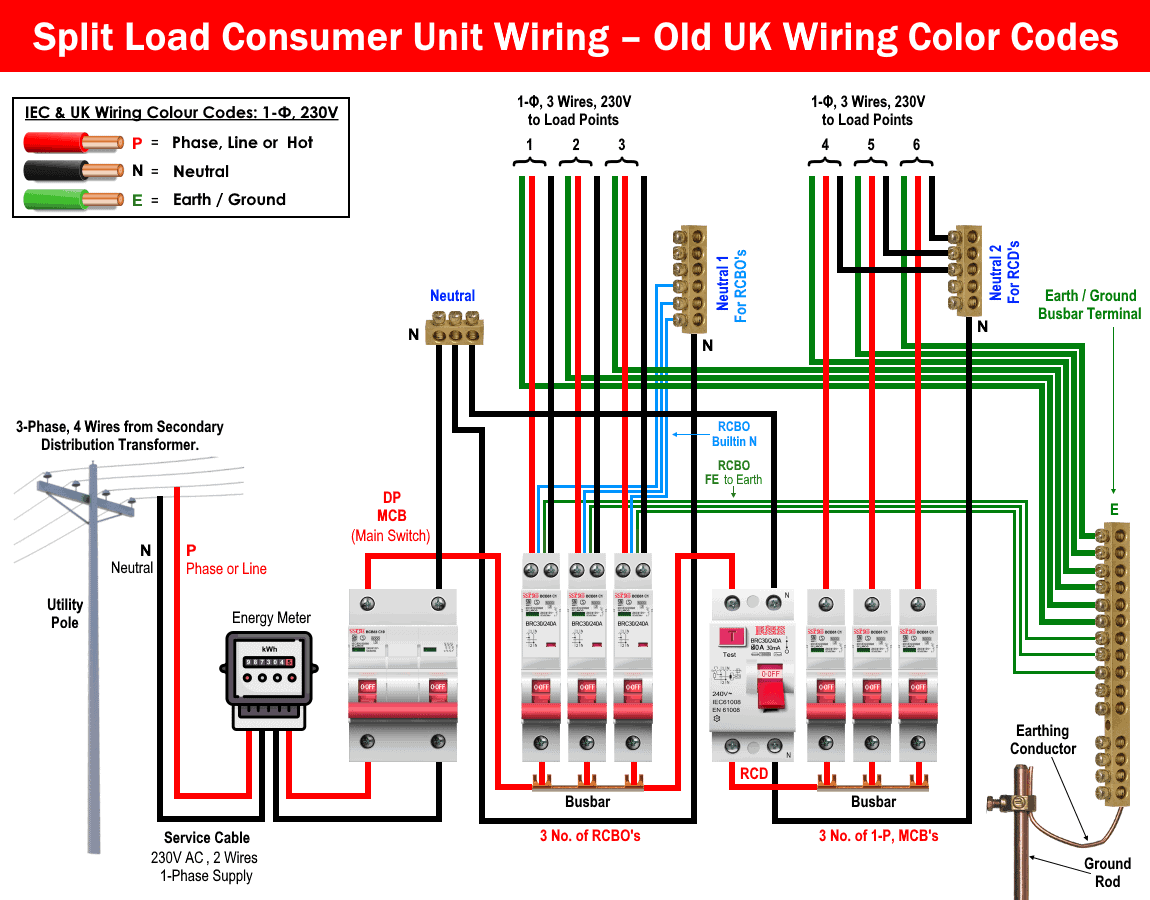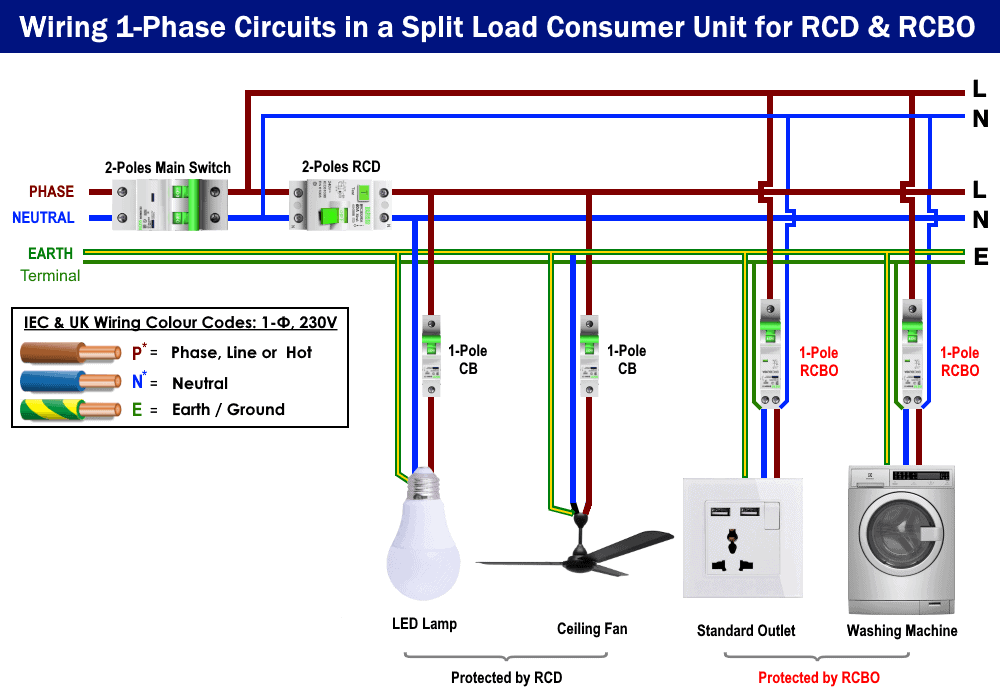How to Wire 1-Phase Split Load Consumer Unit? – RCD+RCBO
Wiring a Single-Phase Split Load Consumer Unit & Distribution Board : IEC, EU & UK
What is a Split Load Consumer Unit?
A Split Load Consumer Unit is also known as High Integrity Consumer Unit which contains both RCD’s and RCBO’s. The single pole MCB’s and associated circuits are protected and controlled by the RCD’s side while the RCBO’s are controlled by the main switch side.
The split load consumer unit is a safest panel box as compared to simple main switch, simple RCD type consumer unit or dual RCD’s consumer unit. It is because split load consumer units provide protection against overload, overcurrent & short-circuit and earth leakage.
Split load consumer unit is the combination of RCBO “Residual Current Breaker with Over-Current“, RCD “Residual Current Device” and MCB “Miniature Circuit Breaker”. You may need more about the protection devices in the previous post under the title of “differences between MCB, MCCB, ELCB & RCB, RCD or RCCB/RCBO Circuit Breakers“.
Related Post:
- How to Wire Single-Phase, 230V Consumer Unit with RCD? IEC, UK & EU
- How to Wire 230V Dual Split Load Consumer Unit? – RCD+MCB
The protection devices in a split load CU do the following jobs.
- MCB = Overload and overcurrent Protection
- RCD = Earth Fault Protection (to avoid electric shock)
- RCBO = MCB + RCD = Earth Fault + Overload and Overcurrent Protection
Good to Know:
RCD (Residual Current Device) and RCBO (Residual Current Device) is the term used in the UK while the same protection device named as GFCI (Ground Fault Circuit Interrupter), GFI (Ground Fault Interrupter), LCDI (Leakage Current Detection Interrupter) and ALCI (Appliance Leakage Current Interrupter).
In addition, for arc fault protection (mentioned first time in the the IET Wiring Regulations 18th edition “BS 7671: 2018”, AFDD (Arc Fault Detection Device) is the term used in the UK while it is known as AFCI (Arc Fault Circuit Interrupter) in the US.
In addition, RCD protection is a must in the consumer unit according to the IEC and IET: 17th edition BS-7671. RCBO & Arc fault protection is recommended in the 18th Edition – 2018.
Components Required:
- A Consumer Unit
- A Two Poles Main Switch MCB.
- A Two Poles RCD .
- 3 No or RCBO’s
- 3 No of Single Poles MCB’s
- Cables and Wires.
Related Post:
How to Wire a Split Load Consumer Unit?
First of all, disconnect the Fuse between kWH energy meter and the utility pole to cut-off the main power supply. Now, connect the service cable (two wires as Phase and Neutral from the utility pole and energy meter) to the single phase two poles main switch.
Now, connect the output Neutral wire from the main switch (as blue color) to the common Neutral Busbar terminal in the consumer unit. Moreover, connect the output Phase wire from the main switch to the RCBO’s via common busbar segment.
In addition, connect the RCD to the output phase wire of the main switch through jumper wire(as brown color). Additionally, connect the single pole MCB to RCD through a common busbar segment as shown in fig. In short, there should be two phase wires from the same line terminal of MCB. The first one for RCBO’s common busbar and the second one for RCD and common busbar for associated MCB’s.
Keep in mind that RCD should be properly installed i.e. the Neutral wire should be connected through Neutral Terminal (The symbol “N” is printed on the RCD nameplate to identify the Neutral terminal.
There are two additional Neutral busbars in the consumer unit viz for RCBO’s and RCD’s (for simplification and illustration). No worries, you may use a single Neutral busbar for this purpose.
The load points and circuits on the RCD + MCB side can be connected via three wires i.e. Phase from single pole MCB, Neutral from Neutral busbar and Earth wire from the Earthing/Grounding busbar.
The case is a little bit different in case of RCBO’s as follows.
There are two built-in wires namely FE “Functional Earth” as white colored wire and N “Neutral” as blue colored wire. The FE should be connected to the main earth terminal block while the N as neutral should be connected to the main neutral terminal.
For load circuits wiring, there are two terminals on the output side of an RCBO viz Phase and Neutral. Keep in mind that load points and circuits can be connected directly to these two terminals i.e. no need to connect the Neutral wire from the main neutral terminal in the consumer unit. In addition, the earth wire should be connected from the main earth terminal. This way, a single phase load circuit is connected through three wires viz Phase, Neutral and Earth wire. The whole process is shown in the fig below.
Click image to enlarge
Related Posts:
- Single Phase Electrical Wiring Installation in Home – NEC & IEC
- Three Phase Electrical Wiring Installation in Home – NEC & IEC
Split Load Consumer Unit Wiring – Old UK Wiring Color Codes
The same wiring of split load consumer unit for RCD and RCBO’s is shown in the following fig having the old UK wiring color codes (prior 2004). This may helpful for the readership outside the UK and EU who still follow the old UK wiring color codes i.e. Black for Neutral, Red for Phase or Hot and Green for earthing.
Click image to enlarge
Fig 2
Related Posts:
- Single-Phase Electrical Wiring installation in a Multi-Story Building
- 3-Phase & 1-Phase Electrical Distribution Wiring Installation in Multistory Building
Wiring 230V Single Phase Circuits in a Split Load Consumer Unit
In a combination of RCD + RCBO distribution board or single phase 230V split load consumer unit, the load circuits should be connected via three wires i.e. Phase, Neutral and Protective Earth. In single phase supply, the voltage between phase and neutral is 230V AC.
The following fig shows how to wire and install single phase 230V load circuits in split load CU. For example, the LED lamp and ceiling fan is controlled and protected by RCD + MCB’s. While the socket outlet and washing machine has been fully protected by RCBO i.e. RCD +MCB in a single unit. To control the ON/OFF operation of the electrical appliances, an SP or DP switches can be used in the sub circuits and final sub circuits.
This way, the protection to the load points are as follows.
- LED lamp & ceiling fan are protected by Main Switch => RCD => Single Pole MCB
- Ceiling Fan & Socket Outlet Protected by Main Switch => RCBO = (RCD + MCB)
Click image to enlarge
Related Posts:
- How to Wire 240V, 208V & 120V, 1 & 3-Phase, High Leg Delta Main Panel?
- How to Wire 277V & 480V, 1-Phase & 3-Phase, Commercial Main Service Panel?
IEC Wiring Color Codes – 1-Φ, 230V – UK & EU
Keep in mind that we have used IEC wiring color codes for illustration purposes only. If not applicable, Please follow the local area codes or general practiced color codes related to specific regions.
In the tutorials above, We have used the IEC wiring color codes (applicable to EU, UK and other countries) as follows.
UK & IEC Wiring Color Codes – Single Phase Supply
- Brown = Phase or Hot
- Blue = Neutral
- Green or Green with Yellow Stripe = PE or Earth Wire.
UK Old Wire Color Codes:
- Red = Phase or Line
- Black = Neutral
- Green = Earth / Ground .
Related Posts:
- How to Wire 120V & 240V Main Panel? Breaker Box Installation
- How to Wire 208V & 120V, 1-Phase & 3-Phase Main Panel?
Safety Precautions
- Disconnect the power supply (and make sure it is really swathed OFF) before servicing, repairing or installing electrical equipment. To do so, switch off the main switch in the main consumer unit or distribution board.
- Never stand or touch wet and metal parts while repairing or installation.
- Read carefully all the cautions and instructions and follow them strictly while doing this tutorial or any other work in practical related to electrical works.
- Always, use the right size cable and wire, proper size outlets and switch and suitable size of circuit breakers. You may also use the Wire and Cable size calculator to find the right gauge size.
- Never ever try to play with electricity (as it is dangerous and can be fatal) without proper guidance and care. Do the installation and repairing work in presence of experienced persons having vast knowledge and good practice who knows how to deal with electricity.
- Doing your own electrical work is dangerous as well as illegal in some cases. Contact the licensed electrician or the electric power supply provider before practicing any change/modification in electrical wiring connections.
- The author will not be liable for any losses, injuries, or damages from the display or use of this information or if you try any circuit in wrong format. So please! Be careful because it’s all about electricity and electricity is too dangerous.
Related Wiring Installation Tutorials:
- How to Wire and Install an Electrical Outlet Receptacle?
- How to wire a GFCI Outlet?
- How to Wire an AFCI Outlet?
- How to Wire Combo Switch and Outlet?
- How to Wire GFCI Combo Switch and Outlet
- How to Wire an AFCI Combo Switch
- How to Wire a GFCI Circuit Breaker?
- How to Wire an AFCI Breaker?
- Staircase Wiring Circuit Diagram – How to Control a Lamp from 2 Places?
- Corridor Wiring Circuit Diagram – Hallway Wiring using 2-Way Switches
- Tunnel Wiring Circuit Diagram for Light Control using Switches
- Hospital Wiring Circuit for Light Control using Switches
- Hotel Wiring Circuit – Bell Indicator Circuit for Hotelling
- Hostel Wiring Circuit Diagram and Working
- Godown Wiring Diagram – Tunnel Wiring Circuit and Working
- How to Wire 120V Water Heater Thermostat – Non-Simultaneous?
- Even More Electrical Wiring Installation & Tutorials









